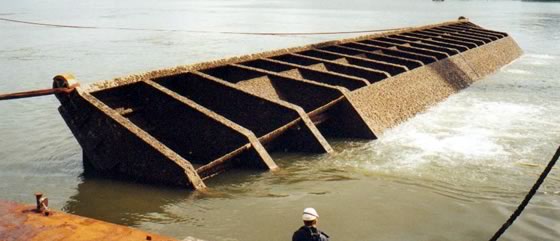Salvage
Each job has to be taken individually, no two jobs are ever the same. However, the same two basic rules apply in every case - make a thorough assessment of the situation and the decide on a course of action.
A sunken vessel cannot sonk any more. Putting lives at risk and plant in unnecesary danger by rushing in woth ill conceived plans and courses of action will be of no benefit. Hulltec have been involved in many salvage operations and have gained invaluable experience over the years in this field. Many of our salvage contracts have involved the recovery of fishing vessels, the most challenging of these having been sunk in the harbour.

In such cases, a safe and quick result is required by those involved to prevent any disruption to the harbour, which may result in further expense.
Other jobs have involved the refloating of coasters that had run aground in Belfast Lough. These vessels, if badly damaged, have to go in to dry dock. This in itself presents the owners with a problem, as no harbour authority will let a badly damaged vessel in to its shipping lanes. Hulltec have overcome situations like these in the past.
Salvage of Belfast Dry Dock Gate

This is one of the largest dry dock gates in the world, and is the largest in Europe. Hulltec worked closely with the management of Harland and Wolff Technical Services and Ship Repair and Marine Services to achieve the successful recovery and dry docking of the gate. Two Hulltec dive teams worked continuously during this salvage. It was made more difficult to the divers having to work inside the gate blanking off access walkways and free flood chambers. Due to the water depth, decompression stops had to be taken in to account in every dive.
When all the blanking off was completed air intake valves and water dump valves had to be fitted. It was vital to the success of the operation that these were fitted in the correct location and that each diver was aware of which valve was fitted to each chamber. If the wrong valves were opened or shut it would have resulted in the ballast chambers becoming over pressurised and bursting or the water not being dumped. If this happened, no buoyancy would be gained, or even worse, the gate would become unstable and turn over causing more damage.
After the inspection in dry dock it was concluded that wear and tear on the hinges had caused the gate to move past the captive bar on the hinges, and due to the ballast condition at the time, sink.
Hulltec were again called on to recover the hinge blocks and replace them after repair.

Salvage of Stone Hopper Barge Formac
This 750 tonne hopper barge was full of her stone cargo when she sank in Larne Lough. An inspection dive was undertaken and it was decided that the first step in re-floating the vessel was to remove the cargo of stone. The vessel was turned upside down by making the starboard side buoyant at low tide. The rising tide lifted that side up and, during high water, air was pumped in to the port side turning the vessel upside down.
At the next low tide divers rigged up the crane to the port side of the barge and attached wires for the tugs on the starboard side of the Hopper. At high water the crane lifted and the tugs pulled the barge in to the correct position for lifting.
Divers then fitted specially adapted hatch covers to the side ballast tanks, pumped out the water, and replaced it with air. This resulted in the successful re-floating of the Formac.
Clients for salvage projects include:
- Sunderland Marine Insurance
- Harland & Wolff SRMS
- Ewing Shipping
- Laganside Corporation
- Alfred McAlpine Pipelines and Services




